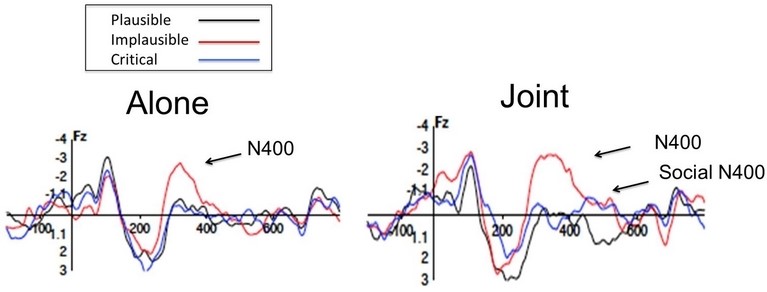The N400 is an ERP component that is part of the brain’s response to words. Several factors affect its amplitude. One important influence is the unexpectedness of a word given the context. If you read the sentence “I take my coffee with cream and dog,” your N400 will be more negative in response to the final word than if you read the sentence “I take my coffee with cream and sugar.”
The nature of this effect gets interesting when you consider sentences that seem unusual by themselves, but make sense given more context. If your friend came up to you and said “I saw a boy with gills,” you would think he was crazy. However, if he said to you, “I was having a weird dream last night. I saw a boy with gills,” your N400 response would likely not be as high in magnitude.
The Social N400 experiment takes this idea one step further. What happens when you have heard the context to an unusual sentence, but someone next to you has not? Consider this scenario:
- You and Allan are alone in a room.
- Allan tells you, “I was having a weird dream last night.”
- Jane walks into the room.
- Allan tells both of you, “I saw a boy with gills.”
Jane will likely get a relatively large N400 effect, but what does yours look like? Previous work by Rueschemeyer et al. suggests that it would be higher than if Jane never entered the room. The Social N400 script is designed to examine this question further. In each trial, a participant first hears an auditory sentence through headphones, and then sees another sentence on the screen. There are 3 conditions.
- Plausible: The sentence on the screen is not unusual in any way.
- Implausible: An unusual sentence is shown on the screen. The auditory sentence did not make it seem normal.
- Critical: An unusual sentence is shown on the screen. The auditory sentence made it seem normal.
In one group of subjects, a confederate is also sitting in the room, but she is not wearing headphones. She is the “Jane” in this scenario—she cannot hear the audio that might give context to the unusual sentence on the screen. In the other group of subjects, each person is in the room by him/herself (and is wearing the headphones).
The results are still being analyzed, but preliminary findings suggest that the Social N400 effect does in fact occur. The image above (created by Olessia Jouravlev) shows the responses to the participants wearing headphones in each condition for both the Alone group and the Joint group.
Using the script requires MATLAB 2013b (or later) with Psychtoolbox installed. You can download the Social N400 scrip here (Zip File – 149 MB).

Comments are closed.